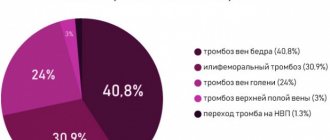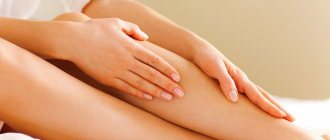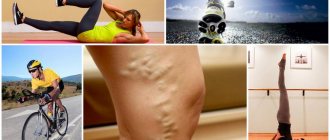- Phlebology Center
- /
- Kaliningrad
- /
- About the clinic
- /
- Helpful information
- /
- Diet for healthy veins
Almost every representative of the fair sex knows what spider veins on the legs are, which not only do not paint women’s legs, but in most cases can be the first symptom of varicose veins and over time turn into large, ugly varicose veins. Phlebologists will help you maintain the beauty and health of your veins. Also, a lot depends on your active lifestyle and proper nutrition.
Diet for varicose veins of the lower extremities
Let us immediately note that patients with varicose veins do not have a specific strict diet, such as, for example, in people with gastric ulcers or in patients with pathologies of the renal system. The main thing to consider when creating a menu is an integrated approach. The diet that needs to be followed in case of varicose veins is more likely to be balanced. This is a higher level of food intake, which allows you to provide the body with all the important components, reduce the risk of diseases and successfully fight existing ones. Eating a balanced meal benefits everyone, not just the person with health problems. There are principles of balanced food intake that apply to schoolchildren, athletes, women during lactation (Lactatio), etc.
Diet for varicose veins of the lower extremities
Most people think that if it’s healthy, it means it’s most likely not tasty. This is an absolute fallacy. Healthy food also has its own taste and visual appeal, for which it is valued by a large number of people. It effectively satisfies hunger, which is important, and helps improve overall health.
Expert opinion
In addition to following the rules of a healthy diet for varicose veins, do not neglect the use of topical products. For example, Normaven® Foot Cream has proven itself well in strengthening blood vessels. This product was developed by highly qualified specialists of the pharmaceutical company VERTEX, has undergone clinical studies and has the entire package of necessary documentation, including quality certificates. Regular use of the cream can improve the condition of blood vessels, get rid of swelling, cramps and fatigue in the legs.
Vascular surgeon, phlebologist
Osipova Ekaterina Yakovlevna
Forbidden food
It is advisable for a person with varicose veins to completely avoid foods such as:
- baked goods;
- salo;
- spicy seasonings;
- walnuts;
- candies;
- cakes, pastries;
- sausages;
- meat and fish of fatty varieties;
- preserves, jams;
- pickles;
- chocolate;
- condensed milk;
- smoked meats;
- ice cream;
- semi-finished products;
- marinades;
- butter;
- bananas;
- canned meat and fish;
- rich broths (including jellied meats, jellies, etc.);
- legumes
Attention: it is necessary to reduce the consumption of foods rich in vitamin K. This substance increases blood clotting, and in large quantities can provoke thrombosis.
“Finding” vitamin K is easy. All green vegetables, as well as herbs and leafy salads, are rich in it. There are many compounds in walnuts, liver, eggs, red meat, and whole milk.
The body needs salt, but in small quantities (about 3-5 g per day). Its excess retains moisture and contributes to the development of swelling.
So, what should be the proper diet for varicose veins on the legs?
Varicose veins develop in the lower extremities. This is physiologically explainable. The maximum load falls on the legs, on the distal section. In this regard, the shins are the first to suffer. Further, if no treatment measures are taken, the disease will progress and even more veins will be affected. Therefore, at the first signs of vascular disease, you need to consult a specialist. He will conduct an inspection and give his recommendations. Some of them will necessarily relate to the patient’s eating behavior.
!
A special diet for the treatment and prevention of varicose veins must be rich in foods enriched with vitamins, plant fibers, fiber, flavonoids, etc.
Below is a list of the most useful foods for varicose veins. They form the basis of proper nutrition for the prevention and treatment of disease. Worth including in your diet:
Meat
Preference should be given to lean varieties of meat and offal: lean beef and veal, white chicken and rabbit meat, liver. For cooking, it is better to choose steamed recipes, variations with boiled, stewed and baked cooking. For example, meatballs, cabbage rolls, cutlets, etc.;
Proper nutrition for varicose veins
Seafood and fish
You also need to choose fatty varieties of fish - herring, salmon, trout, salmon. Cooking methods are similar to cooking meat; it is better to avoid frying. Fish is distinguished by its incredible nutritional value and excellent digestibility. It is also beneficial to add seafood to your diet. Eating squid will promote the synthesis of elastin, a protein that is the main element of elastic fibers of connective tissue. Squids can be stuffed with vegetable filling, or salads can be made with their addition, but without the use of mayonnaise. You can use olive oil and lemon juice as a dressing.
!
Olive oil is rich in both vitamin E and calories - 100 grams of the product contains 884 calories.
Therefore, it is better to spray it from a dispenser onto the salad than to water it. You can saturate your blood vessels not only with elastin, but also with copper and bioflavonoids by eating seaweed. It is simply irreplaceable as part of the diet for varicose veins of the legs;
Berries and fruits
Berries and fruits are the richest source of nutrients and vitamins. Their use helps the body stay in good shape. For a person with vascular diseases, this is simply a must. The maximum benefit will come from berries and fruits containing vitamin C. These are definitely citrus fruits. But you should not consume them in large quantities, otherwise you can harm tooth enamel and the gastrointestinal tract. Kiwi contains even more vitamin C than citrus fruits. It also contains the most valuable enzyme – actinidin, which normalizes the level of blood clotting. Avocado also helps fight vascular diseases; it contains vitamins E, C and the effective antioxidant glutathione.
Among the berries, your attention should be paid to the fruits of black rowan, sea buckthorn and black currant berries. They can be consumed both in pure form and in the form of syrups, and as part of soft drinks in hot weather. Sea buckthorn berries contain a wide vitamin and mineral complex. It is rich in fiber and is rightfully considered a natural multivitamin.
!
But it should be remembered that because of this, sea buckthorn is a strong allergen.
Dried fruits
By adhering to some rules that ensure a healthy diet, you will need to limit yourself in consuming sweets. Dried fruits will help replace them and will be beneficial due to their ability to thin the blood. Pay attention to raisins, dates and dried apricots. They stimulate blood vessels very well.
Vegetables
It is necessary to include as many vegetables as possible in the diet for vascular diseases. No vegetable will harm your diet for varicose veins in the legs. All of them, without exception, are rich in microelements that have a beneficial effect on the walls of venous vessels. Cabbage of all varieties, bell peppers, tomatoes, carrots and greens are of utmost benefit. Make all kinds of salads with a dressing of vegetable oil, sour cream - with everything except mayonnaise. You can also consider apple cider vinegar as a dressing. It has a positive effect on blood thickness;
Nutrition for varicose veins: nuts, beans
Nuts and legumes
Legumes and nuts are rich in vitamins E (tocopherol) and P (rutin). Due to this, they have a tonic effect: they improve the permeability of capillaries and prevent their fragility. The use of these products will help in the prevention of vascular diseases, relieve pain, swelling and even cramps;
Expert opinion
Rutin is a bioflavonoid - one of the most valuable substances for vein health. Its beneficial effect on blood vessels is difficult to overestimate: vitamin P fights excess cholesterol, resists the formation of atherosclerotic plaques, and in combination with vitamin C helps strengthen the walls of blood vessels.
Vascular surgeon, phlebologist
Osipova Ekaterina Yakovlevna
Cereals
Cereals are quite popular in medical nutrition. Buckwheat is considered the record holder for the content of nutrients and vitamins for blood vessels. Moreover, it is low-calorie - there are 92 calories per 100 grams of product. Also in the diet for varicose veins of the lower extremities, pearl barley and barley porridge are preferred;
Beverages
When following a diet, optimal water-salt metabolism should be maintained. The drinking regime should include a sufficient amount of: water, tea, fruit drinks, compotes, juices. Now a little about the requirements. The water should be still, regular drinking water. Tea – weak black, green and herbal (mint is especially useful). Use not only cranberry fruit drinks, but also lingonberry fruit drinks. If possible, drink freshly squeezed juices.
It is not always possible to saturate your body with useful substances and vitamins in the required quantities, even if you conscientiously follow your doctor’s recommendations regarding dietary nutrition. Then additional sources of vitamins, minerals and acids are used. Venotonic products based on plant components with venotonic vitamins and plant extracts contain active natural ingredients that act in several directions at once. Taking one tablet a day can strengthen the walls of venous vessels and cleanse them of cholesterol plaques, improve blood circulation, and reduce capillary permeability and fragility.
Of course, it is worth noting a number of products that should be avoided if you have varicose veins:
- confectionery and baked goods;
- smoked, fried, fatty, spicy, salted;
- coffee and strong black tea;
- alcohol (especially beer);
- canned foods.
Diet for varicose veins of the pelvis: cereals
Diet example
First day
- We have breakfast with oatmeal with the addition of a small amount of raisins.
- During the 2nd breakfast, you can prepare a kiwi and orange smoothie with honey.
- For lunch: buckwheat soup and vegetable salad with Borodino bread.
- Snack: fruit yogurt.
- We have dinner with a portion of fish with the addition of seaweed salad.
Second day
- For breakfast, prepare a serving of low-fat ricotta with fruit and honey.
- For the 2nd breakfast, marmalade or mousse is suitable.
- We have lunch with pumpkin porridge and baked eggplants with tomatoes.
- Snack – carrot and apple salad with yogurt.
- Dinner: a serving of mashed potatoes with beet salad.
Day three
- For breakfast: rice pudding with prunes.
- For second breakfast, prepare a pear with honey and nuts. You can have lunch with onion soup and vegetable casserole.
- Snack - a glass of tomato juice.
- For dinner - steamed chicken meatballs with vegetables.
Fourth day
- Breakfast - steamed cheesecake with fruit.
- 2nd breakfast: smoothie of yogurt and fruit. We have lunch with tomato soup and carrot cutlet with sour cream. Make a cup of vegetable salad.
- For dinner, we recommend boiling chicken breast with mint sauce.
Fifth day
- For breakfast: wholemeal bread with peanut butter.
- Kefir with berries is suitable for 2 breakfasts.
- We have lunch with okroshka and stuffed tomatoes.
- Snack: freshly squeezed apple juice.
- We have dinner with a piece of steamed salmon with lemon sauce. Sixth day
- We have breakfast with buckwheat pancakes with apple sauce.
- For the 2nd breakfast - a handful of pine nuts or dried fruits.
- We have lunch with rice soup and a piece of fish casserole.
- Snack: apple with ricotta. We have dinner with a serving of vegetarian pilaf. We perform unloading on the seventh day.
- Before going to bed, half a glass of kefir or low-fat yogurt without additives is allowed.
Diet for varicose veins of the pelvis
Varicose veins of the small pelvis have recently become quite common. It is diagnosed in both women and men. But, nevertheless, according to statistics, women encounter this disease more often, a possible reason for this may be pregnancy and menopause. Thus, a therapeutic diet is often prescribed to pregnant women, due to the fact that only conservative therapy is indicated for them.
!
For pelvic varicose veins, special attention is paid to intestinal motility.
After all, if for some reason it slows down, then the entire body will be negatively affected. Nutrients will become worse absorbed, problems with defecation (Defecatio) will arise, etc. Therefore, it is very important to adhere to the above rules of food consumption and more often give preference to cereals and vegetables rich in fiber. Also, you should not eat bran and bread. Nutrition should be healthy and rational, containing the required amount of microelements, carbohydrates and proteins.
Vitamins and microelements
The basis of vascular elasticity is the balance of vitamins and minerals in the human body, which regulate metabolic and redox processes. Diseased blood vessels desperately need these substances. They can be found in the following products:
| Useful material | Where are they kept? |
| Vegetable fiber | Vegetables, fruits, grains, bran |
| Vitamin C | Cranberries, citrus fruits, currants, gooseberries, greens, spinach |
| Vitamin P | Apples, tomatoes, greens, cherries |
| B vitamins | Cereals, eggs, meat, milk, cheese, fish, nettles |
| Vitamin A | Carrots, mint, red bell peppers, peaches |
| Vitamin E | Sprouted wheat, vegetable oils, nuts, eggs, caviar, corn |
| Bioflavonoids | Green tea, berries |
| Calcium | Savoy cabbage, parsley, sesame, beans, soybeans |
| Potassium | Cocoa, dried fruits, nuts, mushrooms |
| Zinc | Egg yolk, pine nuts, beef liver, soy, potato, radish |
| Omega 3 fatty acids | Seafood, olive oil, sea fish |
| Silicon | Beans, cereals, soybeans, grapes |
| Copper | Seafood, seaweed, liver, cocoa |
| Iodine | Seafood |
| Phosphorus | Pumpkin, bran, beans, poppy seeds, cheese |
Diet for varicose veins of the esophagus
Varicose veins of the esophagus occur due to a violation of the outflow of blood from the venous vessels of the esophagus through the portal and superior vena cava system. This venous disease is typical for patients of any age.
!
At the same time, the incidence of the disease in men is twice as high as in women; this is mainly due to excessive consumption of alcohol-containing drinks.
The diet for esophageal vein disease comes down to excluding a number of foods from the menu. Their list is given above. It can only be supplemented with a product such as sugar, the use of which will also have to be abandoned.
It is also important to eat large portions; the longer the gap between meals, the better. In no case should you neglect breakfast. In the morning, you should give preference to fatty foods: omelet, scrambled eggs, cod liver.
Fully or partially limited products
Strong meat broths, fatty varieties of red meat, goose meat, duck meat, boiled and smoked sausages, canned meat, bacon, ham, cooking and animal fat, mayonnaise, baked goods, confectionery, as well as heavy cream, cottage cheese, sweets are excluded from the diet. cheesecakes and yogurt, baked milk, fried chicken eggs, salty and fatty cheeses, semolina and oatmeal, pasta, legumes, white rice.
Table salt and salty foods, dishes, spices and seasonings that stimulate the appetite are subject to restrictions.
Limit the consumption of coffee and black tea.
The consumption of smoked meats, marinades, and alcohol-containing drinks is not allowed.
Table of prohibited products
| Proteins, g | Fats, g | Carbohydrates, g | Calories, kcal | |
Cereals and porridges | ||||
| wheat bran | 15,1 | 3,8 | 53,6 | 296 |
Confectionery | ||||
| cake | 3,8 | 22,6 | 47,0 | 397 |
Cakes | ||||
| cake | 4,4 | 23,4 | 45,2 | 407 |
Chocolate | ||||
| chocolate | 5,4 | 35,3 | 56,5 | 544 |
Raw materials and seasonings | ||||
| mayonnaise | 2,4 | 67,0 | 3,9 | 627 |
Dairy | ||||
| milk | 3,2 | 3,6 | 4,8 | 64 |
| cream 35% (fat) | 2,5 | 35,0 | 3,0 | 337 |
| sour cream 30% | 2,4 | 30,0 | 3,1 | 294 |
Cheeses and cottage cheese | ||||
| cheese | 24,1 | 29,5 | 0,3 | 363 |
Meat products | ||||
| fried pork | 11,4 | 49,3 | 0,0 | 489 |
| pork fat | 1,4 | 92,8 | 0,0 | 841 |
| bacon | 23,0 | 45,0 | 0,0 | 500 |
Sausages | ||||
| smoked sausage | 28,2 | 27,5 | 0,0 | 360 |
Bird | ||||
| duck | 16,5 | 61,2 | 0,0 | 346 |
| goose | 16,1 | 33,3 | 0,0 | 364 |
Fish and seafood | ||||
| fried fish | 19,5 | 11,7 | 6,2 | 206 |
Oils and fats | ||||
| cooking fat | 0,0 | 99,7 | 0,0 | 897 |
| rendered pork fat | 0,0 | 99,6 | 0,0 | 896 |
Alcoholic drinks | ||||
| white dessert wine 16% | 0,5 | 0,0 | 16,0 | 153 |
| vodka | 0,0 | 0,0 | 0,1 | 235 |
| cognac | 0,0 | 0,0 | 0,1 | 239 |
| liquor | 0,3 | 1,1 | 17,2 | 242 |
| beer | 0,3 | 0,0 | 4,6 | 42 |
Non-alcoholic drinks | ||||
| cola | 0,0 | 0,0 | 10,4 | 42 |
| coffee | 0,2 | 0,0 | 0,3 | 2 |
| Pepsi | 0,0 | 0,0 | 8,7 | 38 |
| black tea | 20,0 | 5,1 | 6,9 | 152 |
| energy drink | 0,0 | 0,0 | 11,3 | 45 |
| * data is per 100 g of product | ||||
Video: nutrition for varicose veins - what is possible, what is not
is not responsible for the accuracy of the information presented in this video clip. Source – Vascul Clinic Group
Sources:
- Rymashevsky N.V. and others. Varicose veins and recurrent phlebitis of the pelvis in women. – Rostov-on-Don, 2000. – 163 p.
- Tsukanov Yu.T., Tsukanov A.Yu., Vasilevich V.V. Orthostasis-dependent phlebopathy of the lower half of the body as a vascular effect of connective tissue dysplasia // Mater. 1 All-Russian scientific-practical conf. “Current issues of internal pathology. Connective tissue dysplasia." – Omsk, 2005.
- Yushchenko A.N. Varicose veins of the small pelvis: a casuistry or a common disease? // News of medicine and pharmacy.–2005. – No. 9 (169)
- Dultsev Yu. V., Titov A. Yu., Kamenetskaya T. M., Korneva T. K. et al. Methods of treating varicose veins // Surgery, 2013.
- Diet for varicose veins. Potapova M.V.
- https://www.sibmedport.ru/article/3933-pitanie-pri-varikoznoy-bolezni/
- FLAVONOIDS OF MEDICINAL PLANTS: PREDICTION OF ANTIOXIDANT ACTIVITY. Kurkin V.A., Poroikov V.V., Kurkina A.V., Avdeeva E.V., Pravdivtseva O.E. // Modern problems of science and education. – 2015. – No. 2.
- https://www.medicalnewstoday.com/articles/321562.php
- https://top-diet.com/diet-for-varicose-veins-2/
- https://www.healthyandnaturalworld.com/improve-varicose-veins-naturally/
For an accurate diagnosis, contact a specialist.
#1: Blueberries
Blueberries are one of the greatest gifts of nature known to man at all times. It is simply irreplaceable for all people prone to varicose veins. Thanks to their high concentration of anthocyanins (flavonoid pigments), blueberries help restore the collagen matrix of the vascular wall by removing free radicals and neutralizing enzymes that destroy connective tissue. Flavonoids also restore damaged proteins that form the framework of the venous wall. Moreover, blueberries are a good source of fiber such as pectin. Among all berries, blueberries are one of the best sources of vitamin E.
#6: Beetroot
Regular inclusion of beets in your diet can help prevent varicose veins. Betacyanins, the phytochemicals responsible for the intense red color of beets, are known to significantly reduce homocysteine levels. Homocysteine is an amino acid that can cause damage to blood vessels. Elevated homocysteine levels are one of the most powerful risk factors for venous thrombosis. Not many people know, but green beet tops are also edible and very nutritious, so don't throw them away, add them to your salad.
#3: Avocado
Avocados are full of natural compounds that help fight varicose veins. This fruit, and perhaps also a vegetable (the debate still continues), contains large amounts of vitamin C and E, two key elements that support healthy blood vessels. Avocado is also one of the top 10 foods with high concentrations of glutathione and tripeptide molecules. These compounds protect the heart, veins and arteries from damage by oxygen radicals. Glutathione is essential for vitamins C and E to function properly. Another bonus of this food is that avocados contain fewer pesticides and other harmful chemicals.










